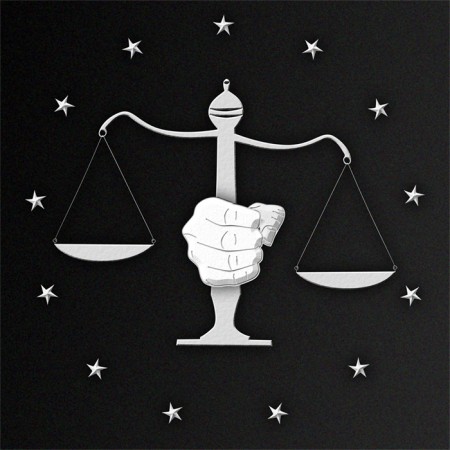This post goes into a bit of background detail about world of my upcoming Red Bargain trilogy.
When beginning work on The Red Bargain I knew I wanted it to be set in a society that was oppressive,

Symbol for the Synod: the Lawgiver’s hand holds the Scales of Justice; thirteen stars representing the High Judges surround the Scales.
chauvinistic and theocratic, but I also recognised the need for it to be believable. Personally I abhor the very idea of an oppressive theocracy, but in fiction I find it can be very evocative. (note, It is not a direct analogy for any real religion or society; while it does certainly allow for certain parallels to be drawn to the real world I leave that down to the reader and am not writing with the intent of making a political or religious statement.)
When choosing a name for the religious establishment and working out how the hierarchy would work I tried out a few names, some of which though seemed a little too close to names from other books, or too long winded to really ring true. ”Ministratum” was one early choice, as you can see if you read through early blog posts on here, but I settled on the name ‘Synod’. Synod used to simply refer to the council of a church, or its ruling body, and seemed to fit the role perfectly.
In The Red Bargain the rulers of the Synod are the thirteen High Judges. Their number is prime, and therefore any votes they make cannot result in a stalemate – abstention is not an option for High Judges. Their rule is absolute; in fact some interpretations of the Synod’s scriptures all Judges are said to be infallible, so the very idea of a High Judge being flawed is considered by some to be next to heresy and treason – in this society the two are one and the same. No single High Judge has been set above the others since the time of the Ancient Judges thousands of years ago, when the Lawgiver entrusted rule of the realm to his brother, Azinor, who was set above the other twelve.
Beneath the High Judges are the many Judges, and beneath those are Magistrates then Barristers and finally Clerks who function as little more than local sheriffs or small-town priests. Barristers function more as internal bureaucrats rather than public-facing leadership roles. At the bottom of the ladder for male Synod members are lay-brothers, who perform a similar function to Clerks but are not sworn to the role for life. The only women employed by the Synod are lay-sisters, who despite their name are distincly below lay-brothers on the ladder and serve more menial roles. The Synod also employs many professional guards, soldiers and servants, though they are viewed as employees rather than directly as members.
In The Red Bargain there is no difference between the Church of the Synod and the political / legal structures of the state of Balthon – they are one and the same. As well as their legal activities, Judges also serve as an equivalent to both a local king or lord and a bishop or high priest. A common curse in Balthon is to refer to someone or something as being guilty – which is essentially the same as saying “damned”.
The power of the Synod lies in their possession of magickal objects, many of which are as ancient as the Synod itself, and their ability to imbue objects with the Power, which shall be explored in more detail at a later date.